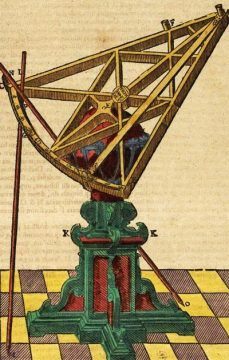Kitty Ferguson in Delancey Place:
 One of the underappreciated keys to launching the scientific age was the work of Tycho Brahe. His contribution was simple but revolutionary: At a point just before the invention of the telescope, he wanted to precisely record the positions of the planets and the stars. However, the instruments used before him to make these measurements produced unreliable results. Brahe was a Danish nobleman, and thus deemed to be above such pursuits as astronomy. But as a nobleman, he had the financial means of only a very few. He cast aside convention to spend a lifetime making better instruments to take these more precise measurements of the stars and planets, and then used those instruments to make measurements far superior to any that had been previously made. It was this revolutionary work that allowed his student Johannes Kepler to come up with his three laws of planetary motion. And it was Kepler’s work that was so helpful to Sir Isaac Newton and his laws of thermodynamics.
One of the underappreciated keys to launching the scientific age was the work of Tycho Brahe. His contribution was simple but revolutionary: At a point just before the invention of the telescope, he wanted to precisely record the positions of the planets and the stars. However, the instruments used before him to make these measurements produced unreliable results. Brahe was a Danish nobleman, and thus deemed to be above such pursuits as astronomy. But as a nobleman, he had the financial means of only a very few. He cast aside convention to spend a lifetime making better instruments to take these more precise measurements of the stars and planets, and then used those instruments to make measurements far superior to any that had been previously made. It was this revolutionary work that allowed his student Johannes Kepler to come up with his three laws of planetary motion. And it was Kepler’s work that was so helpful to Sir Isaac Newton and his laws of thermodynamics.
The first revolutionary instrument Tycho Brahe constructed was in Herrevad Abbey, Denmark, in 1572, which he called the “half-sextant”:
“One of Tycho’s first undertakings at Herrevad was to construct a new astronomical instrument, a ‘half-sextant’ with straight walnut legs and a curved brass arc. A little later he added a larger, interchangeable sixty-degree arc. It was this sixty-degree arc that gave a ‘sextant’ its name — probably coined by Tycho himself. Sixty degrees is one-sixth of a circle; a half-sextant has a thirty-degree arc. Sextants and half-sextants resemble slices of pie. By sighting along the two legs or sides (where the pie is ‘cut’) — pointing one leg toward one star and the second leg toward another, for example — it was possible to measure the angular distance between two heavenly bodies. One could similarly measure a body’s altitude above the horizon.
More here.
